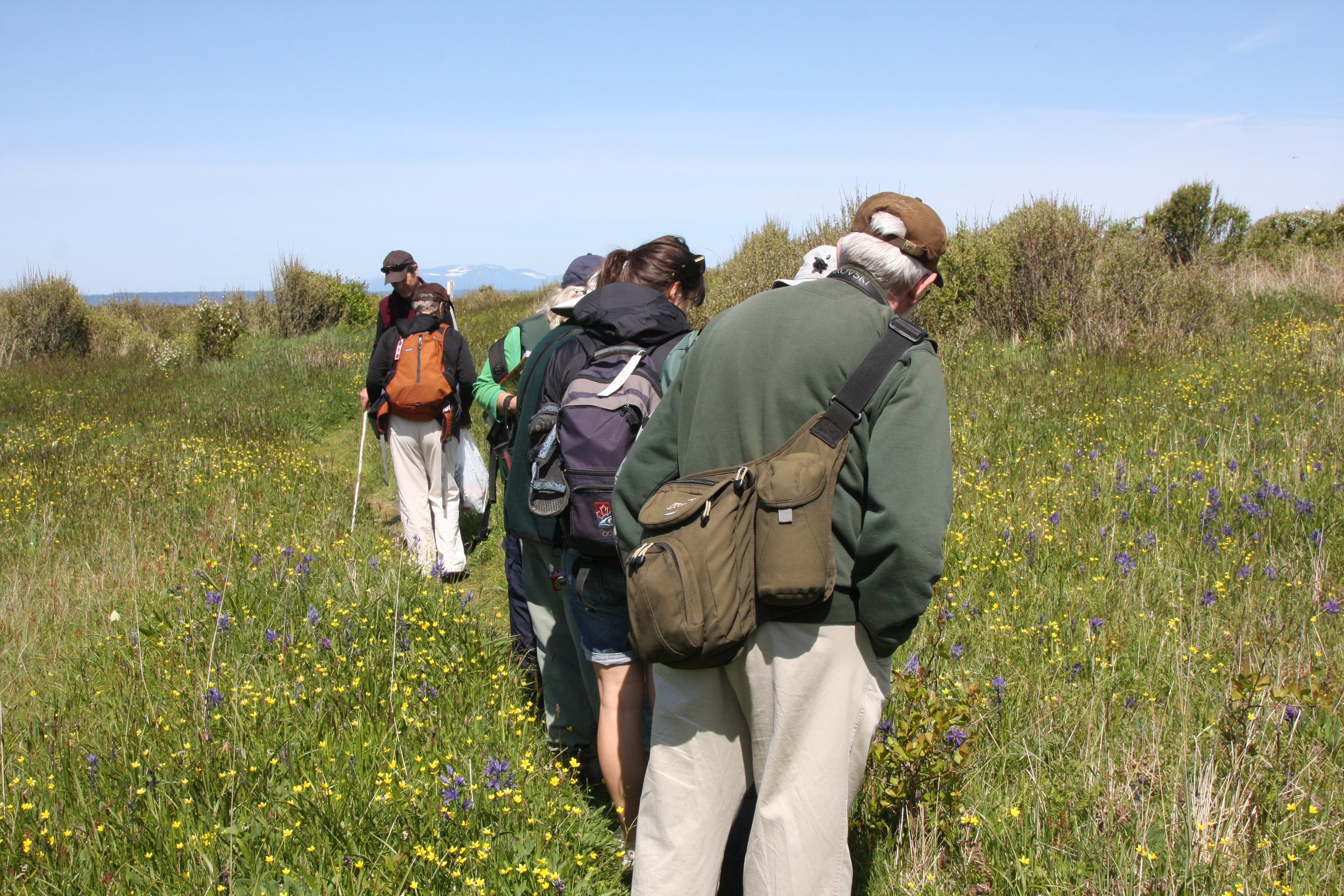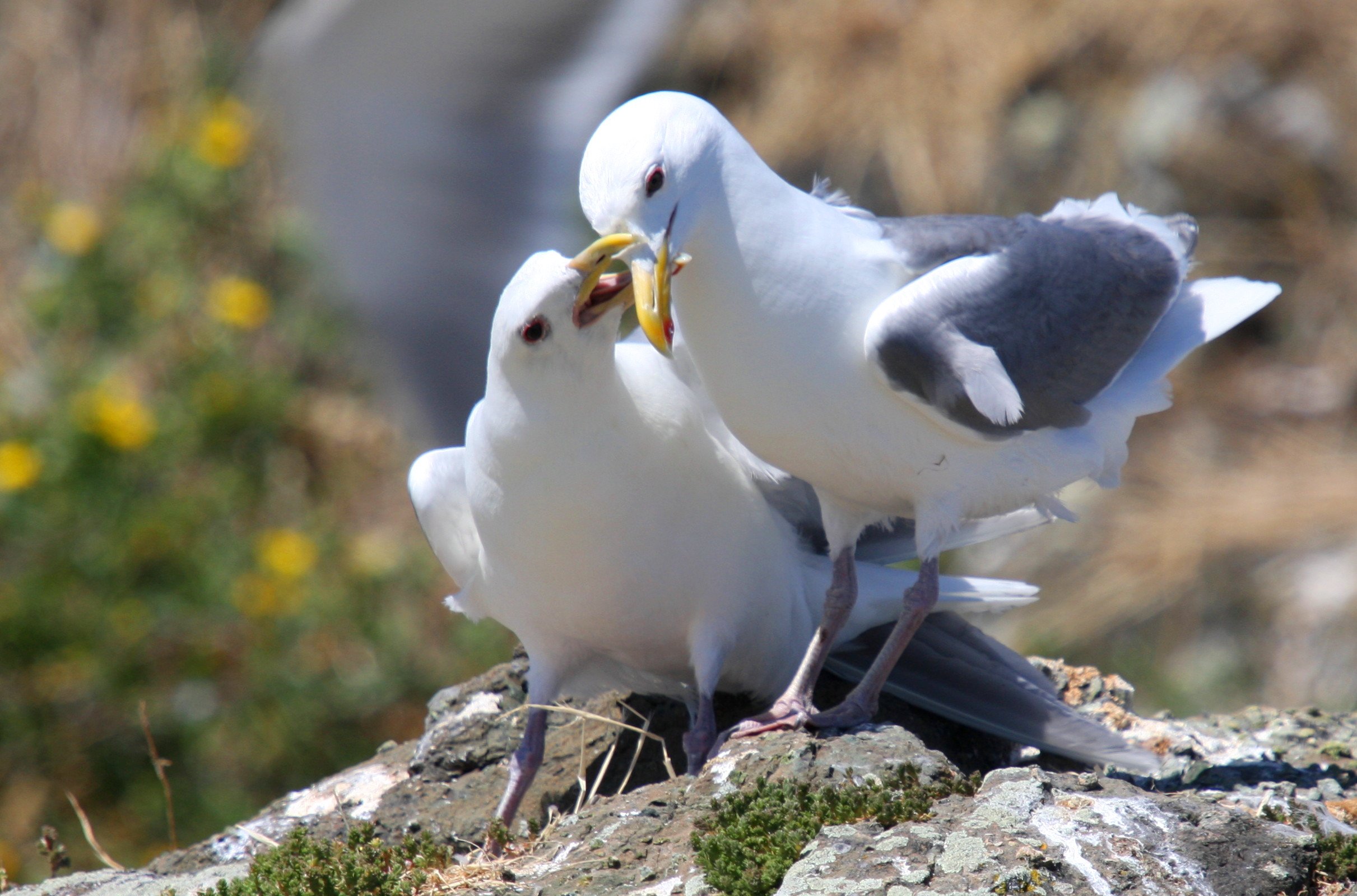Mitlenatch Island
Mitlenatch Island is a small rocky island that features semi-arid conditions caused by the island’s location in the “rain shadow” of Vancouver Island. The park receives less than 75 cm (30 inches) of rain each year – about half the Campbell River average. Rain-bearing clouds pass eastward from the Pacific Ocean and drop much of their moisture on Vancouver Island. As they descend across the Strait of Georgia, they warm and pick up new moisture, which will be dropped on the Coast Mountains of mainland British Columbia.
Accessible by boat only, Mitlenatch Island Nature Provincial Park offers excellent opportunities to observe and photograph wildflowers and birds. Visit in May when the island’s meadows of spring wildflowers are in bloom, or in late May to July when the harvest brodia blooms and in the last half of June when the coastal cactus bloom.
History
Mitlenatch Island is within the territories of Coast Salish and Kwakwakaʼwakw First Nations. Mitlenatch is an Indigenous word with a number of meanings. In Coast Salish it has been translated to mean “calm waters all around”. Perhaps the most descriptive meaning comes from the Sliammon language where “metl” meant calm and “nach” meant posterior. Calm (waters) behind is an apt description of the island during stormy weather. To the Kwagiulth people “mah-kwee-lay-lah” meant “it looks close, but seems to move away as you approach it”.
Traditionally, Mitlenatch was used by First Nations for foraging and gathering, including egg collecting, camas harvesting, and fishing. Traditional fishing weirs can still be seen during low tide in Camp Bay.
Mitlenatch was once owned by the Manson family of Cortes Island, who raised cattle and sheep on the island. Cattle were butchered on the island and the meat rowed to Comox; sheep were ferried to the island in spring and removed in late autumn. To discourage “mutton pickers”, the family lived on the island in a driftwood cabin during 1892. Today, nothing remains of the Manson’s activities.
In 1959, the Province of British Columbia purchased Mitlenatch from the Manson family estate and in 1961 it was designated as a Provincial Nature Park.
In addition to being a provincial park, Mitlenatch is one of 600 internationally recognized Important Bird Area (IBA) in Canada.
Maps
Mitlenatch Island Trails
Rockfish Conservation Zones Surrounding Mitlenatch Island
Nesting Birds
Mitlenatch Island Nature Provincial Park is home to the largest seabird colony in the Strait of Georgia. This nature reserve is an important nesting colony for thousands of Glaucous-winged Gulls, as well as Pelagic Cormorants, Pigeon Guillemots, Black Oystercatchers and many other species of birds.
Glaucous-winged Gulls
About 1,000 pairs of Glaucous-winged Gulls nest on Mitlenatch Island. This large gull with grey wing tips is the common gull of Georgia Strait. Adults start arriving in April to stake out breeding territories (a small circle in the grassy rock outcroppings), which are fiercely defended until their young fledge.
Eggs, which are buff to pale olive and spotted or blotched with darker brown, begin to appear about late May, with the first eggs hatching in late June (the incubation period is about 27 days). Almost as soon as the young hatch the can move around. Instinctively they peck at the red spot on their parent’s bill. This stimulates the parent to regurgitate warm partly digested food, which the chick devours.
By the end of August most young gulls have left the island. Banding studies indicate that most of the grey-brown juveniles winter within 100 km (60 miles) of Mitlenatch.
Pelagic Cormorants
There are about 173 Pelagic Cormorant pairs nesting on Mitlenatch. These birds build nests of seaweed and grass, cemented together with guano, on narrow ledges on the steep cliff faces. The 4 to 6 eggs are light bluish white. Pelagic Cormorants feed on small fish.
Double-crested Cormorants
There are about 26 Double-crested Cormorant pairs on Mitlenatch. They build stick nests on flatter ground on the crest of steep cliffs.
Northwestern Crow
The Northwestern Crow is one of the more conspicuous birds on Mitlenatch Island. Their bulky platform nests, built in the pine forest, thickets and sometimes on the ground, hold 3 or 4 bluish green, mottled eggs. Crows are omnivorous, relishing crabs, clams, berries, seabird eggs, carrion and regurgitated gull food.
Pigeon Guillemots
Pigeon Guillemots nest under large boulders and driftwood and in rock crevices near the water. Nests are lined with a few chips of rock, shell or wood. The 2 eggs are very pale grey with small dark blotches. Guillemots feed on small fish. A few minutes of watching guillemots lounging on the rocks (each with a freshly caught fish in their beaks) is a great way to observe the diversity of local small fish.
Black Oystercatchers
Black Oystercatchers nest on the beach above high tide line. Oystercatcher nests are a “scrape,” a depression in the ground, lined with small pebbles and shell fragments. The 2 to 3 eggs are light grey with small dark blotches. If an oystercatcher is agitated, exhibiting alarm behaviour (calling and pacing) or even walking away, you may be near a nest and should immediately leave. When an oystercatcher leaves its nest, crows, ravens, and other predators will rush in to steal eggs or eat chicks. Oystercatchers feed on shellfish, especially limpets.
Flowers
From late April, Mitlenatch’s meadows flower with a procession of blooms. Early spring sea blush, fawn lilies, camas, shooting stars, and chocolate lilies are quickly followed by tiger lilies, stonecrops, wild onions bluebells, fireweed and brodiaeas.
By late summer the show is over; dry grass turns golden and the meadows rattle with seedpods.
Snakes
Don’t be alarmed if you see a large, dark snake on Mitlenatch Island. These are harmless Western Terrestrial Garter Snakes, some of the largest garter snakes in British Columbia. On Mitlenatch they may grow to more than 90 cm (36 inches). Dark grey with black markings, they blend into the rocks along the beach, where they are often seen sunning, swimming and feeding on small fish such as sculpins and blennies.
Marine Mammals
Mitlenatch is a favourite haul out for Harbour Seals and our two species of sea lions, Northern (Steller’s) and California. Harbour Seals find safe haven on the island for pupping during the summer months. Sea lions are generally present only in late autumn until late spring. River Otter can often be seen swimming close to shore. Harbour Porpoise and Killer Whales are frequently seen off shore. Killer Whales, which move quickly, hugging the island, are mainly “transient” whales hunting Harbour Seals. These whales eat marine mammals, in contract o the local resident Killer Whales, which feed on salmon.
Marine Life
Low tide reveals a brilliant mosaic of intertidal life on the island’s rocky shores. Explore tide pools to find colourful small fish and marine invertebrates, including sponges, sea anemones, and sea starts (at least 12 species of sea stars have been found here).
Eelgrass beds in shallow bays are rich with small fish, such as shiners, pipefish, sculpins, sand dabs and greenling.
Geology
The bedrock of Mitlenatch Island is a volcanic basalt that formed from lava. The large, light coloured granite boulders scattered on Mitlenatch Island are glacial erratics, dragged by ice from the last ice age, from nearby Bute Inlet.
Climate
Due to prevailing summer westerlies and the rain shadow effect of the high mountains of Vancouver Island, this rocky island receives less than 75 cm (30 inches) or rain each year. In summer, almost desert-like conditions are ideal for sun-loving plants, including Prickly Pear Cactus, which can be seen on the rocks on the upper trail from Northwest Bay to the bird blind.
Trees
The shallow dry soils of Mitlenatch are not well suited to trees. Recent suppression from fires (which occasionally swept the island historically) has allowed shore pines to colonize the meadows. Other trees on the island include Douglas-fir, bitter cherry, Scouler’s willow, black hawthorn, red alder, and trembling aspen.
Aerial View of Trails






